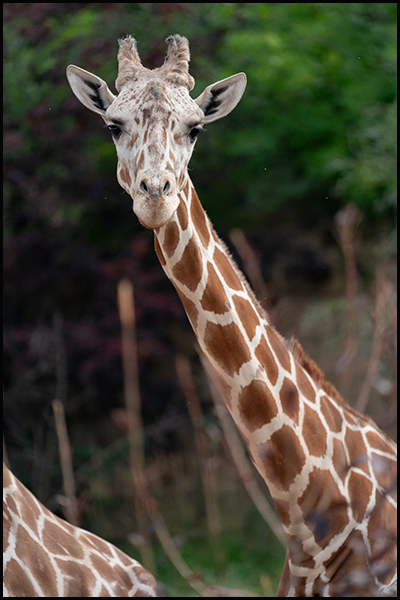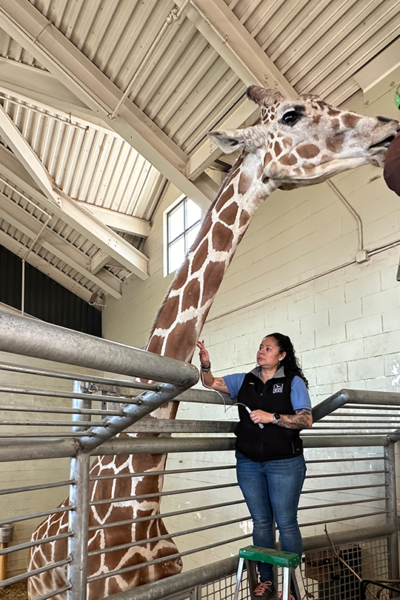If you’ve ever wondered if animals have blood types, you’re not the only one! The International Center for the Care and Conservation of Giraffe, at Cheyenne Mountain Zoo (The Giraffe Center), recently teamed up with Dr. Lily Parkinson, clinical veterinarian at Brookfield Zoo Chicago, and several more giraffe care teams to help find out. Dr. Parkinson is leading a study to see if giraffe have different blood types and if it is common for giraffe to have compatible blood types.

“In small animal emergency medicine, blood typing is common knowledge,” said Brenda Cordova, RVT, hospital manager at Cheyenne Mountain Zoo. “In our larger zoo animals, we’ve never really had the opportunity to find out, because we haven’t had as much access to test their blood on a large scale like this. Now that so many giraffe are trained to participate in voluntary blood draws, this could lead to some really exciting discoveries that help us fine-tune giraffe care even more.”
Dr. Parkinson says different molecules that live on the surface of red blood cells make one blood type different from another – in people and in animals. An animal’s immune system can attack anything it perceives is a ‘foreign invader.’ If the immune system detects different molecules on transfused blood cells, the body might attack those red blood cells and destroy them.
Typically, before a blood transfusion, care teams will draw the recipient’s blood and mix it with a drop of already processed plasma from the donor. Veterinary teams will watch for reactions between the two bloods and move ahead if there are no obvious negative reactions.
“Many people know about the incredible nationwide giraffe plasma bank that can help treat newborn giraffe calves that need extra help,” said Dr. Parkinson. “The findings from this blood typing study could take that science another step further to help us give these calves the most compatible and helpful plasma transfusions.”
This study hopes to reveal how to test giraffe for compatible blood types. If giraffe do have different blood types, giraffe care teams could do additional testing to have better confirmations that a donor’s blood isn’t going to harm the recipient.
To achieve dependable findings in a study like this, you need a lot of data. In this case, that requires a lot of giraffe willing to donate their blood. Dr. Parkinson reached out to Amy Schilz, senior animal behaviorist at The Giraffe Center and giraffe care co-manager at Cheyenne Mountain Zoo, to help her enlist volunteers.

“When Dr. Lily reached out for potential contributors for this study, it was a perfect example of how The Giraffe Center can serve as a central resource for all things giraffe care,” said Schilz. “Because we have worked with so many giraffe care teams across the country, we already knew which herds are trained to give blood voluntarily, and we knew how to get everyone together for this important study that supports what we all want: to take the best care possible of giraffe.”
A few phone calls and a multi-zoo video conference later, 13 zoos accredited by the Association of Zoos and Aquariums and one private facility were on board to contribute to the study. In the end, around 60 giraffe voluntarily submitted blood for the study.
Seven of those samples came from giraffe at Cheyenne Mountain Zoo. Schilz, the giraffe care team in African Rift Valley and the CMZoo veterinary team came together over a few days to gather those samples, leaning on their established training and relationships with the long-necked donors named Mashama, Msitu, Twiga, Bailey, Laikipia, Muziki and 1-year-old Wednesday.
“This was Wednesday’s first time giving blood, and she was incredible,” said Schliz. “There was a hush that fell over the barn when we saw her approach her team with such trust and remain completely unbothered throughout the session. This little giraffe is already making a big impact. We are so impressed with her.”
The blood draw sessions are voluntary and the participating giraffe at CMZoo are eager to earn the reinforcers – usually yummy rye crackers – they receive during training sessions. They can choose to walk away at any time, and our veterinary technicians use a specialized blood draw setup so the needle falls out if the giraffe walks away.
“It goes to show how important it is to proactively train for these volunteer behaviors,” said Cordova. “Training allows us to take the best care of the animals as individuals, and it also allows us to respond to these calls to contribute to the greater giraffe community’s shared knowledge.”
As giraffe care teams learn more about blood typing for giraffe, CMZoo will share updates.

